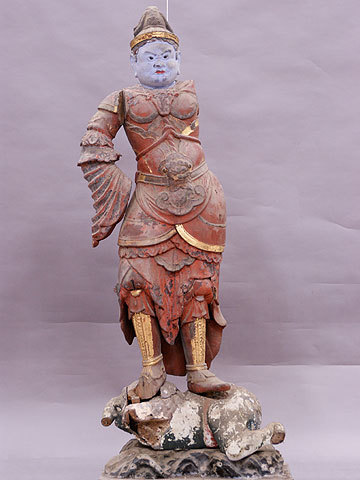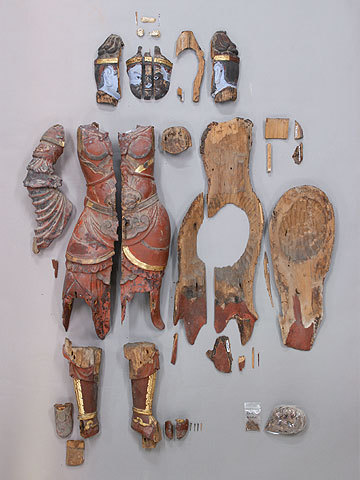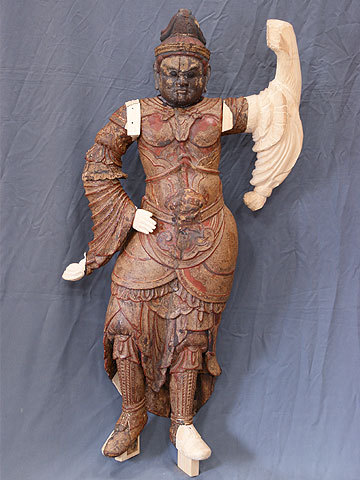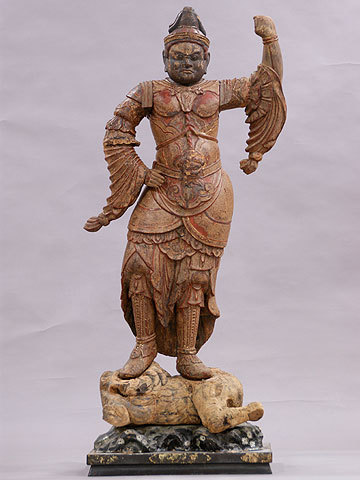"Nippon(=Japan)"- the Land of Carved Statues.
KIBI BUNKAZAI SHUFUKUSHO
Kibi Conservation Studio for Cultural Objects

Since ancient times, our nation has held the belief that everything contains its own deity.
Since the introduction of Buddhism and Buddhist art in 6th century Japan, we regarded the Buddha as a deity, and started to express our beliefs in sculpture. During the next 1500 years, many statues were made - the exact number is unknown. Although many of them were destroyed in times of civil war, it is possible that several million images still exist - equivalent to the population of a small country.
Most of these sculptures are of carved wood, with decorations varying from lacquer, gold leaf, pigments, and quartz to elaborately engraved metal. Even though these wooden images are not really suited to the climate of the Japanese islands with its extremes of temperature and humidity, they are not just considered as inanimate objects, but have been cherished and cared for just as children are - to be passed on from generation to generation. Images have survived for centuries and even for a thousand years, inherited by 77 thousand Buddhist temples - large and small - all over Japan, and also in Shinto temples and private houses. It could be said that these carved images are the hidden "Spiritual Citizens" of Japan.
"Nippon" is a country of carved images, the elaborate traditional techniques and sensibilities being inherited as a foundation to the whole range of our culture, not only in the modern pioneering industries, but also in the subcultures such as animations and character dolls.

The current state of Buddhist sculptures
Surprisingly, these images have not always existed in peaceful stability. When Japan accepted Western civilization in 1868, only 150 years ago, Japanese culture was changed dramatically, and the familiar "Spiritual Citizens" were put at serious risk of destruction.
By order of the new government, more than half of the Buddhist temples were amalgamated, and of the many, now homeless, "refugee" Buddhist images, a large number were destroyed or burnt- some lucky ones became "guest Buddhas" of other temples, and many others were taken abroad.
Those remaining were not properly maintained, merely surviving, with the care and protection of a few good people.
30 years later, that turbulent period began to settle, and the authorities started a selective programme of conservation - with a system of designated cultural assets including the newly established concept of "Buddhist Images". Until then, some had been restored and conserved by the efforts of local groups of people, but that work was makeshift, and not properly considered for the long term. It was only fairly recently that there was a comprehensive programme of revival for the Buddhist temples - a whole new attitude to the cultural landscape after the defeat of Japan in World War 2.
The Buddhist statues began to be given proper consideration after a long chaotic century, but still only limited numbers benefitted - in the same way that many people still lack proper medical care and treatment. Under the pressures of globalization, indigenous traditional cultures in every country are in crisis, and huge efforts and financial supports are essential to preserve them. The future position of these images is equally uncertain.
Kibi Conservation Studio is dealing with the conservation and restoration of the "hidden citizens" of Japan - Buddhist images - to save for the future as many of them as we can, just as local hospitals and doctors are treating the people.
Captions to photographs -
- More than 70 Buddhist statues are contained within the large and small buildings
of this single temple.
- This one building houses nearly 300 parts of broken Buddhist images.
- Three thousand devout people queued up over three days to celebrate the unveiling
of the restored "Secret Buddha" - a project which had taken several decades to complete.
Profile of Kibi Conservation Studio
1.History
Kibi Conservation Studio was established by Takao Makino in 1988, recognising those classical sculptures, such as the Buddhist images, as an indispensible baton of a relay race to protect the tangible history and culture for the future, by preserving them to be handed on in a better condition. We are working daily to become a bridge linking the past and the future through conservation and restoration.
2.The Purpose of the Establishment
Under the wide umbrella of preserving the material cultural heritage, our aim is to restore and conserve classical sculptures, (Statues of Buddha and of minor deities), and also to study and build up a body of knowledge of traditional techniques from the practical experience we have gained during the processes of treating those objects. Then we can return this regained knowledge to society through various activities - further restoration and production work, and the publication of reports. The Kibi Conservation Studio aims to balance all these activities.
3.Activities:
- a) Conservation and restoration of Buddhist and Shinto images.
- b) Study of classic traditional techniques.
- c) Production.
- d) i: Research into conservation techniques;
ii: Development of a skilled work force through training students and apprentices;
iii: Publicising the work of the Studio - through displays & presentations;
iv: Publication of technical reports.
i: Example of recent work
The conservation of a Buddhist statue - the main activity of the Kibi Conservation Studio.
title: "Standing Vaisravana"
origin: Japan
period: Heian, late 12th century
material: Hinoki cypress wood
Construction:
This statue was originally made from many separate pieces of wood joined together - the head and body each having several different components. During the carving process, the inside of the body section was hollowed out in order to reduce weight, and to prevent warping and splitting as the timber continued to dry out. The outer surface had been painted with lacquer, then gilded and painted in colours.
Damage:
The purpose of the conservation treatment was to return the image as closely as possible to its original state, and to make it strong enough to be able to stand without a support.
Figure 1. Before treatment

Figure 2. The dismantled parts during treatment

Figure 3. The missing parts replaced with newly carved pieces - showing white in the photograph - before being painted.

Figure 4. The statue in its final state

ii: Developing Human Resources
Since the establishment of the Studio, we have been diligently selecting keen young people who are interested in the opportunity to study the techniques of conserving and restoring Buddhist images. Nearly twenty men and women have learnt practical skills with us, progressed to become staff members, and then moved on to become enthusiastic graduate students, members of other workshops, staff at museums, and independent craftspeople. We also accept special research fellows from other countries.
iii: Special Lectures
Occasionally we give special lectures - technical briefing sessions on conservation and restoration, and reports on completed projects.
iv: Publishing conservation reports
These are currently only in Japanese. They are available for purchase on request.
連絡先メールアドレスは、当面英文ホームページ中には入れないので以下は無視
For further questions, please contact to: xxxx@xxxx.co.jp

設立目的
吉備文化財修復所は、仏像や神像など日本の古典彫刻の修復・調査・研究・人材育成を目的として設立されました。
概要
社名:吉備文化財修復所
住所:さいたま市北区植竹町1-587-5
設立:昭和63年10月20日
代表:牧野 隆夫
業務:古典彫刻の修復・研究・制作およびそれらに関連する仕事



